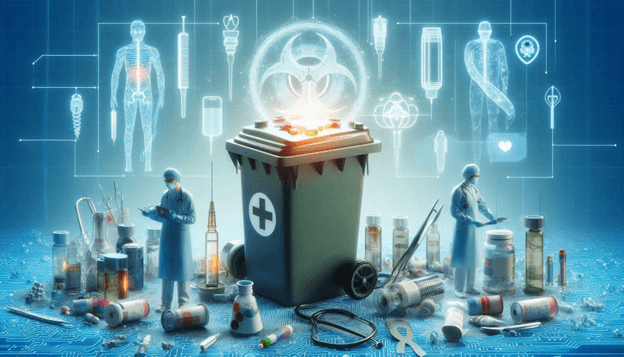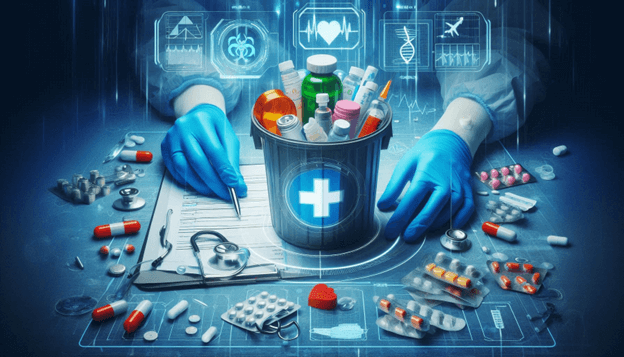Medical Waste Management: Addressing a Growing Concern in Healthcare
Published Date: 12 Oct 2024
Introduction
Healthcare organizations worldwide are developing a growing concern in medical waste disposal. The stream of waste production grows in parallel with the development of the given sector. Hazardous waste handling and disposal can only be done and implemented appropriately to contain environmental pollution and protect the health of the community and the workforce attending to sick people. This blog will focus on what kind of medical waste exists, why proper management is important, the current technologies, challenges, and the feasibility of long-term solutions.

Types of Medical Waste
Medical waste includes all types of waste and each type requires a specific method of disposal. Medical waste is categorized by the World Health Organization (WHO) into multiple categories:
Infectious waste
Organic waste that contains blood or other Clements / IESabm. IESabm Waste Classification 2 Other body fluids are considered infectious waste because they can be fatal. Items such as disposable syringes used bandages, and samples of bacterial culture that teem with various disease germs also sit in this category. Second, they include waste from isolation units of patients who require a strict no-touch policy to prevent the spread of disease. Contaminated waste is required to be managed in the right way to minimize the risk of infections to patients, staff, and even the community. Due to this, treatment of this kind of waste is important as a way of reducing the chances of infection within the hospital environment.
Pathological Waste
Any human material that is used in a clinical context and is left over from treatment by a healthcare professional or an autopsy is labeled pathological waste. It also encompasses the animal remains and body parts used for research, these are more dangerous because they are likely to contain biohazards. This type of garbage is a carrier of disease and a threat to the ecosystem, so handling it incorrectly poses a severe threat to people. Since these items may be hazardous to the environment or the general public, proper disposal methods are therefore essential.
Sharps Waste
The stool, which contains; Needles, syringes, scalpels, and any other object that is capable of causing harm or possible transmission of an infectious agent, is recognized as sharps waste. Disposal is crucial particularly because these objects can easily puncture through the flesh and in the process spread disease-bearing bacteria. As a result, they need to be placed in puncture-resistant containers specially designed for sharps to prevent harm to the handlers of the trash and the health care personnel. The safety of hospital environments and stopping the transfer of diseases calls for proper disposal of sharps waste.
Chemical Waste
chemical waste refers to products that one uses in a laboratory and which are in excess or leftovers from a chemical reaction for example solvents, chemical reagents, or disinfectant solutions. Physical waste on the other hand is any leftovers that are physically used up in any laboratory activity for instance biological material wastes. Other wastes as heavy metals from batteries and medical equipment among others are also catered for. Failure in the management of chemical wastes results in pollution of the environment and hence a great danger to human beings and animals. That is why it is dangerous and certain rigorous guidelines must be followed in order not to harm the environment or human health when handling such waste.
Effective Medical Waste Management Is Essential
- Environmental Protection: Inadequate disposal of medical waste leads to pollution of the earth’s air, water, and land which suffer severe damage. Some wastes may emit adverse effects on the atmosphere during combustion and toxic materials can leech into the water table.
- Public Health Safety: Medical waste can cause infections and diseases and therefore can be lethal. The health of the community is protected as well as transmission of disease is prevented through proper handling and disposal.
- Safety of Healthcare Workers: SCs and other wastes are regarded as potential risks of harm or infection to healthcare workers. Measures of controlling waste ensure their safety and minimize occurrences of work-related mishaps.

- Regulatory Compliance: Various governments as well as different health organizations have put in place measures that ensure limited medical waste treatment. To preserve the credibility of healthcare organizations and to eliminate any legal consequences, legal rules have to be obeyed.
Prospects for the Future and Ecological Remedies
- Innovative Technologies:
New technology is making waste treatment procedures more environmentally friendly and effective in the process. That is why plasma gasification could be the sustainable solution for incineration that converts the trash into energy by with ionized gas.
- Circular Economy Methods:
According to the circular economy concept, recycling and material reuse form the basis of efforts meant to minimize wastage. This may involve refurbishing used medical equipment, recycling plastics used in the manufacture of healthcare products, or finding new uses for effluent waste in healthcare systems.
- Digital Solutions:
Waste management procedures can benefit from the Internet of Things and blockchain technology. Smart IoT devices especially are advantageous in the determination of collection schedules and tracking of garbage levels, Blockchain on the other hand provides transparency of records on disposal of wastes.
- Education and Training:
To select waste management strategies that enhance the quality, value, and sustainability of waste management in healthcare facilities WHO has now stimulated healthcare and facility managers, as well as professionals, regarding naively enhancing waste management techniques. Seminars and forms of education can impart necessary information and skills to staff members to deal with garbage.
- Policy and Regulation:
For proper waste management, measures should be enhanced and disposal checked and should be standardized. Different governments and health organizations should demand people to stick to certain guidelines and develop clear rules on one’s own.
Conclusion
The concern that has rapidly emerged with harsh effects on the safety of healthcare workers, public health, as well as the environment is medical waste management. There is a need for a program aimed at identifying, isolating, accumulating, processing, and removing or getting rid of the waste. Nevertheless, the challenges are still present; there are prospects for their overcoming: novel technologies, digital tools, the circular economy concept, legal initiatives, and improvements in education.
The process of developing a strong and good healthcare system cannot disregard these key factors that are associated with medical waste management as the healthcare sector evolves. Appropriate management of waste poses great importance to overall health, the environment, and professionals in healthcare facilities.
Maximize your value and knowledge with our 5 Reports-in-1 Bundle - over 40% off!
Our analysts are ready to help you immediately.
